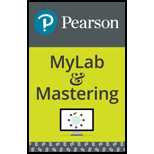
(a)
Interpretation:
The given
Concept introduction:
The oxidizer is the species whose oxidation state decreases during the course of reaction and reducer is the species whose oxidation number increases. Oxidized product is the oxidation product of the reducer and reduced product is the reduction product of the oxidizer.
(b)
Interpretation:
The given redox reaction is spontaneous or nonspontaneous is to be stated.
Concept introduction:
The oxidizer is the species whose oxidation state decreases during the course of reaction and reducer is the species whose oxidation number increases. Oxidized product is the oxidation product of the reducer and reduced product is the reduction product of the oxidizer.
Want to see the full answer?
Check out a sample textbook solution
Chapter 17 Solutions
EP INTRODUCTORY CHEM.-MOD.MASTERINGCHEM
- Order the following oxidizing agents by increasing strength under standard-state conditions: Mg2+(aq), Hg2+(aq), Pb2+(aq).arrow_forwardFor the reaction Cu2+(aq) + Zn(s) → Cu(s) + Zn2+ (aq), why can’t you generate electric current by placing a piece of copper metal and a piece of zinc metal in a solution containing CuCl2(aq) and ZnCl2(aq)?arrow_forwardThe mass of three different metal electrodes, each from a different galvanic cell, were determined before and after the current generated by the oxidation-reduction reaction in each cell was allowed to flow for a few minutes. The first metal electrode, given the label A, was found to have increased in mass; the second metal electrode, given the label B, did not change in mass; and the third metal electrode, given the label C, was found to have lost mass. Make an educated guess as to which electrodes were active and which were inert electrodes, and which were anode(s) and which were the cathode(s).arrow_forward
- Calculate K at 25°C for each of the reactions referred to in Question 31.arrow_forwardActually, the carbon in CO2(g) is thermodynamically unstable with respect to the carbon in calcium carbonate(limestone). Verify this by determining the standardGibbs free energy change for the reaction of lime,CaO(s), with CO2(g) to make CaCO3(s).arrow_forwardCalculate G at 355 K for each of the reactions in Question 17. State whether the reactions are spontaneous.arrow_forward
- Some metals, such as thallium, can be oxidized to more than one oxidation state. Obtain the balanced net ionic equations for the following oxidation reduction reactions, in which nitric acid is reduced to nitric oxide, NO. a Oxidation of thallium metal to thallium(I) ion by nitric acid. b Oxidation of thallium(I) ion to thallium(III) ion by nitric acid. c Oxidation of thallium metal to thallium(III) by nitric acid. [Consider adding the a and b equations.]arrow_forwardAn aqueous solution of an unknown salt of gold is electrolyzed by a current of 2.75 amps for 3.39 hours. The electroplating is carried out with an efficiency of 93.0%, resulting in a deposit of 21.221 g of gold. a How many faradays are required to deposit the gold? b What is the charge on the gold ions (based on your calculations)?arrow_forwardWhat is the standard cell potential you would obtain from a cell at 25C using an electrode in which Hg22+(aq) is in contact with mercury metal and an electrode in which an aluminum strip dips into a solution of Al3+(aq)?arrow_forward
- Consider the following cell running under standard conditions: Fe(s)Fe2+(aq)Al3+(aq)Al(s) a Is this a voltaic cell? b Which species is being reduced during the chemical reaction? c Which species is the oxidizing agent? d What happens to the concentration of Fe3+(aq) as the reaction proceeds? e How does the mass of Al(s) change as the reaction proceeds?arrow_forwardHow is the pH scale defined? What range of pH values corresponds to acidic solutions? What range corresponds to basic solutions? Why is pH = 7.00 considered neutral? When the pH of a solution changes by one unit, by what factor does the hydrogen ion concentration change in the solution? How is pOH defined? How arc pH and pOH for a given solution related? Explain.arrow_forwardAn electrode is prepared from liquid mercury in contact with a saturated solution of mercury(I) chloride, Hg2Cl, containing 1.00 M Cl . The cell potential of the voltaic cell constructed by connecting this electrode as the cathode to the standard hydrogen half-cell as the anode is 0.268 V. What is the solubility product of mercury(I) chloride?arrow_forward
 Chemistry: Principles and ReactionsChemistryISBN:9781305079373Author:William L. Masterton, Cecile N. HurleyPublisher:Cengage Learning
Chemistry: Principles and ReactionsChemistryISBN:9781305079373Author:William L. Masterton, Cecile N. HurleyPublisher:Cengage Learning General Chemistry - Standalone book (MindTap Cour...ChemistryISBN:9781305580343Author:Steven D. Gammon, Ebbing, Darrell Ebbing, Steven D., Darrell; Gammon, Darrell Ebbing; Steven D. Gammon, Darrell D.; Gammon, Ebbing; Steven D. Gammon; DarrellPublisher:Cengage LearningChemistry: Matter and ChangeChemistryISBN:9780078746376Author:Dinah Zike, Laurel Dingrando, Nicholas Hainen, Cheryl WistromPublisher:Glencoe/McGraw-Hill School Pub Co
General Chemistry - Standalone book (MindTap Cour...ChemistryISBN:9781305580343Author:Steven D. Gammon, Ebbing, Darrell Ebbing, Steven D., Darrell; Gammon, Darrell Ebbing; Steven D. Gammon, Darrell D.; Gammon, Ebbing; Steven D. Gammon; DarrellPublisher:Cengage LearningChemistry: Matter and ChangeChemistryISBN:9780078746376Author:Dinah Zike, Laurel Dingrando, Nicholas Hainen, Cheryl WistromPublisher:Glencoe/McGraw-Hill School Pub Co Chemistry & Chemical ReactivityChemistryISBN:9781337399074Author:John C. Kotz, Paul M. Treichel, John Townsend, David TreichelPublisher:Cengage Learning
Chemistry & Chemical ReactivityChemistryISBN:9781337399074Author:John C. Kotz, Paul M. Treichel, John Townsend, David TreichelPublisher:Cengage Learning Chemistry & Chemical ReactivityChemistryISBN:9781133949640Author:John C. Kotz, Paul M. Treichel, John Townsend, David TreichelPublisher:Cengage Learning
Chemistry & Chemical ReactivityChemistryISBN:9781133949640Author:John C. Kotz, Paul M. Treichel, John Townsend, David TreichelPublisher:Cengage Learning Chemistry: The Molecular ScienceChemistryISBN:9781285199047Author:John W. Moore, Conrad L. StanitskiPublisher:Cengage Learning
Chemistry: The Molecular ScienceChemistryISBN:9781285199047Author:John W. Moore, Conrad L. StanitskiPublisher:Cengage Learning





